On Aug. 12, the opening ceremony of the Youth Action on Green Agri-Heritage: Global Cultural Symbiosis officially began in Shanghai, coinciding with International Youth Day. The event was designed to connect China's agricultural cultural heritage and global youth-driven innovation via field visits, international youth roundtable dialogues, co-creation camps designed to inspire young participants through collaborative practice and nurture a new generation of creators with global communication influence with the involvement of renowned visual design mentors that infuse the events with diverse artistic perspectives, and other endeavors.
The theme for the 2025 International Youth Day is "Local Youth Actions for the Sustainable Development Goals (SDGs) and Beyond." It also marks the 30th anniversary of the adoption of the World Programme of Action for Youth (WPAY) – the first action plan on policies and programs for youth – which aligns closely with the Youth Action on Green Agri-Heritage: Global Cultural Symbiosis and the corresponding goal of promoting youth participation in cultural heritage conservation. The opening ceremony was held in the Shanghai People's City Practice Exhibition Hall, presenting a vivid picture of how Shanghai striving to build itself into a best practice zone for people-centered urban development.
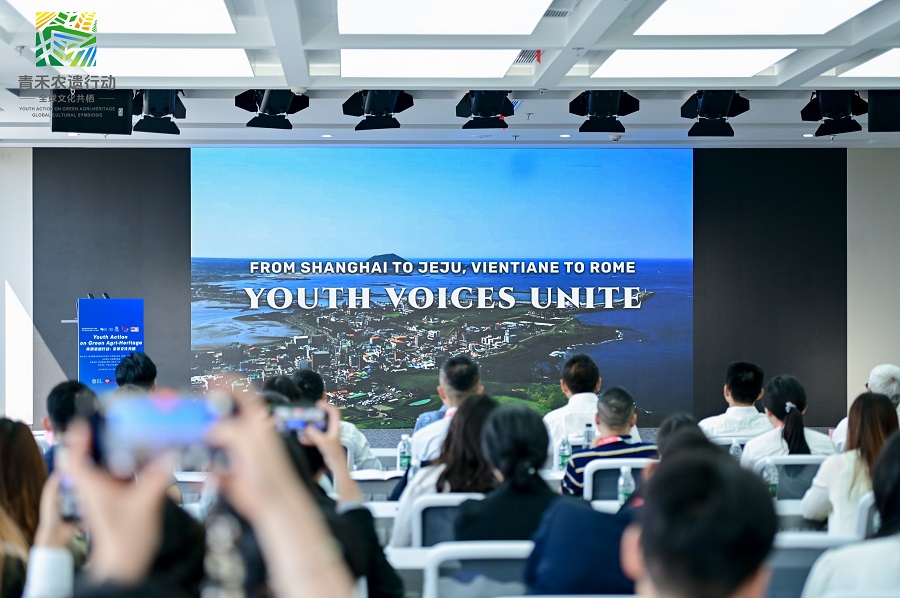
A view of the Youth Action on Green Agri-Heritage: Global Cultural Symbiosis opening ceremony
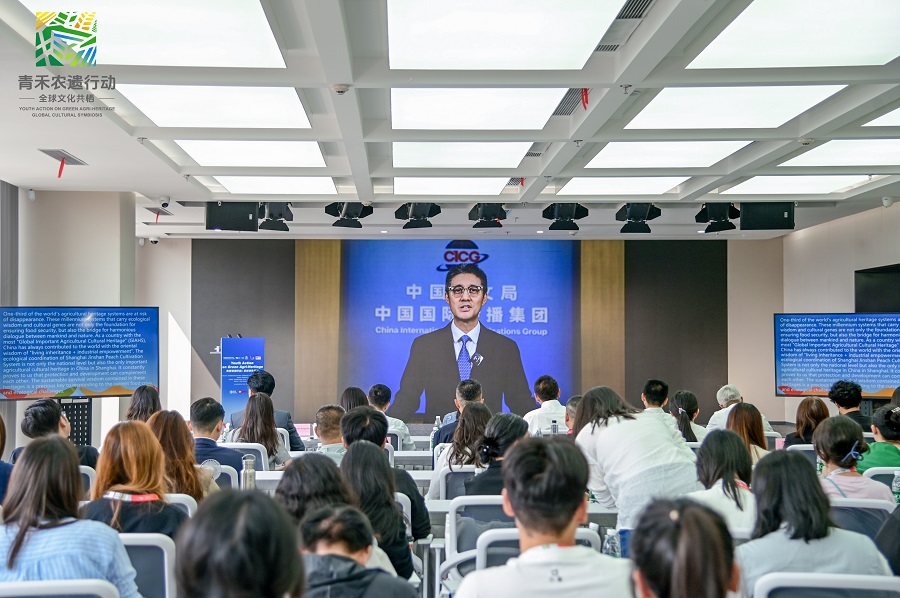
Gao Anming, editor-in-chief of the China International Communications Group and director of the China Internet Information Center (CIIC), delivers opening remarks via pre-recorded video during the launch ceremony.
Gao Anming, editor-in-chief of the China International Communications Group and director of the China Internet Information Center (CIIC), delivered opening remarks via pre-recorded video during the launch ceremony. He stated that China, as the country with the largest number of "Globally Important Agricultural Heritage Systems" (GIAHS), has always contributed to the world with the Eastern wisdom of living heritage + industrial empowerment. He noted that the Youth Action on Green Agri-Heritage: Global Cultural Symbiosis is an innovative exploration in international communication to promote dialogue among civilizations. "We are conveying to the world, through multilingual and multi-format communication, a core message: agricultural heritage is by no means a static museum exhibit, but a source of human wisdom in addressing challenges. Every recorded image and every cross-disciplinary dialogue will become part of the civilizational mosaic for building a community with a shared future for humanity," Gao said.

Zhou Lijin from the Food and Agriculture Organization of the United Nations (FAO) Representation in China delivers opening remarks during the launch ceremony.
Zhou Lijin from the Food and Agriculture Organization of the United Nations (FAO) Representation in China delivered opening remarks during the launch ceremony. She said that youth are not merely the inheritors and beneficiaries of agricultural heritage. Recognizing youth as drivers of change is key for promoting their engagement and employment in agri-food systems. The World Food Forum China (WFF China) offers a critical platform to engage young people with passion and creativity, incubate youth-led innovation, and drive sustainable agricultural development. Through sharing innovative experiences from heritage sites, this event encourages young participants to break conventions, discuss social, economic and environmental issues in depth, and offer youth-driven solutions for the sustainable innovation of agricultural heritage systems.
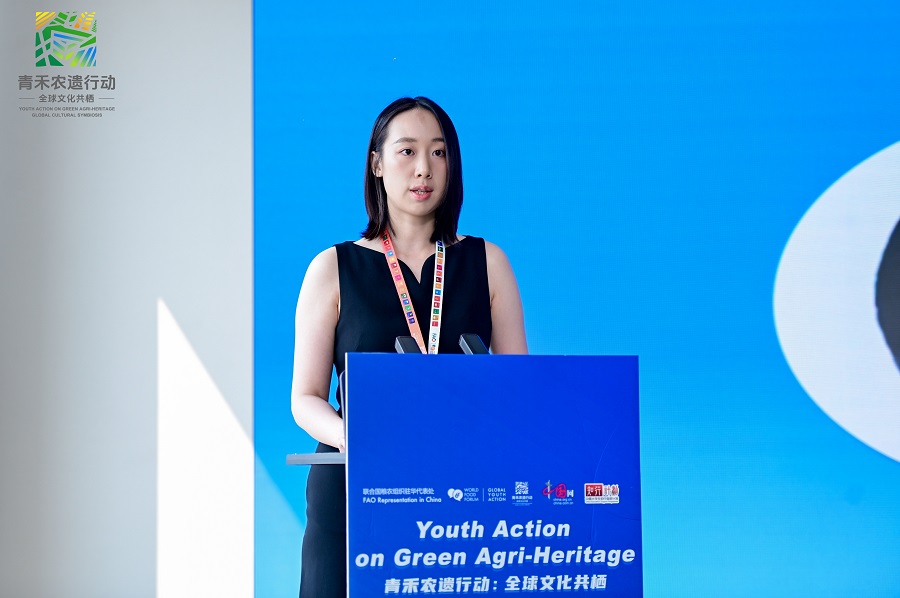
Zeng Zixin, Center of International Cooperation Service (CICOS), Ministry of Agriculture and Rural Affairs delivers opening remarks during the launch ceremony.
Zeng Zixin from the Center of International Cooperation Service (CICOS) of the Ministry of Agriculture and Rural Affairs said in her remarks that since the FAO launched the GIAHS initiative in 2002, China has been one of its earliest responders, a staunch supporter, a successful practitioner, a key promoter, and a major contributor. As of August 2025, China has 25 GIAHS, ranking first in the world. "We will keep on conserving, utilizing, passing on and developing China's agricultural heritages. By unlocking their economic, social, cultural, ecological, and scientific potential, we aim to leverage China's GIAHS for rural revitalization, contributing to global food security and the implementation of the United Nations 2030 Agenda for Sustainable Development," she said.

A view of the Youth Action on Green Agri-Heritage: Global Cultural Symbiosis opening ceremony. From left to right: Li Zhong, WFF China representative; Chanthalath Pongmala, assistant of FAOR (Programme) (HIHI Focal Point and Youth Supervisory Board) of FAO Laos; Ni Bing, deputy secretary of the Party leadership of Yangpu District government, Shanghai; Min Qingwen, researcher of Institute of Geographic Sciences and Natural Resources Research, Chinese Academy of Sciences, and director of the GIAHS Expert Committee, Ministry of Agriculture and Rural Affairs; Zheng Wenhua, deputy secretary of the Party committee of CIIC; Chen Hui, member of the Party leadership group & deputy director of Shanghai Municipal Food and Strategic Reserves Administration; Takeuchi Ryo, Japanese director from Hezhimeng Media Nanjing.
The WFF China and the CIIC officially launched the Youth Action on Green Agri-Heritage: Global Cultural Symbiosis program on Tuesday, with the goal of establishing a series of activities focused on cultural exchange and mutual learning pertaining to GIAHS and fostering multi-stakeholder engagement from UN agencies, agricultural departments from multiple countries, media, authoritative experts, public figures and youth participants. The initiative will unfold through exchanges and video releases showcasing youth-driven innovations related to agricultural heritage, with activities held in Shanghai of China, Jeju Island of South Korea, Vientiane of Laos, and Rome of Italy.

Min Qingwen, researcher of Institute of Geographic Sciences and Natural Resources Research, Chinese Academy of Sciences, and director of the GIAHS Expert Committee, Ministry of Agriculture and Rural Affairs delivers a keynote speech on GIAHS.
Min Qingwen, researcher of Institute of Geographic Sciences and Natural Resources Research, Chinese Academy of Sciences, and director of the GIAHS Expert Committee, Ministry of Agriculture and Rural Affairs delivered a keynote speech on GIAHS and its protection. He emphasized that the systematic, living, and dynamic characteristics of agricultural cultural heritage as well as its multi-functional value. Regarding the current problems of declining rural population and widening urban-rural gap, he believes that it is necessary to inject new vitality into rural areas, and that the dynamic protection and sustainable development of agricultural cultural heritage may be achieved through the participation of young people.
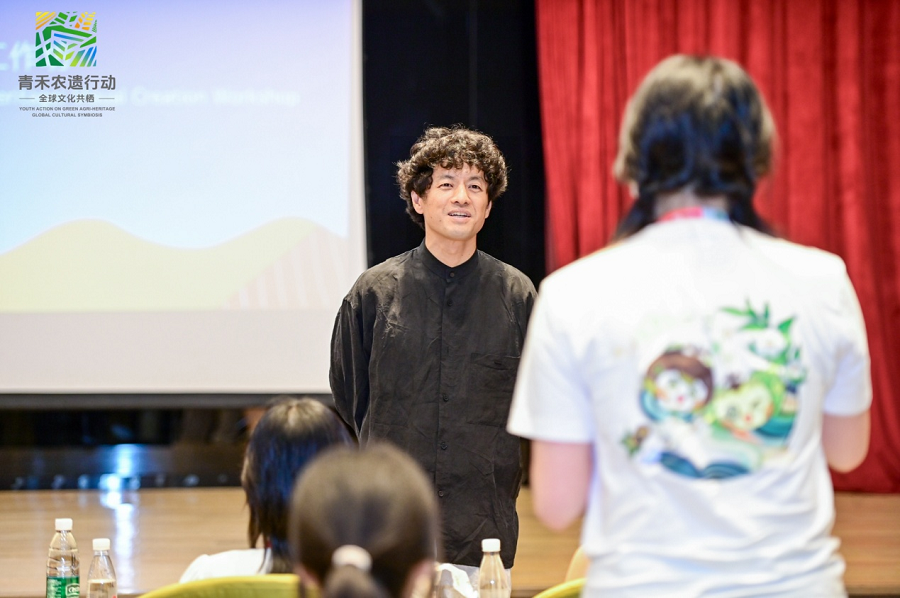
Renowned Japanese director Takeuchi Ryo hosts the Youth Action on Green Agri-Heritage: Visual Creation Workshop, sharing insights on cross-cultural documentary filmmaking with young representatives from various countries.
During the event, a special visual screening section showcased the beauty of farming. A team of international youth delegates led by Takeuchi Ryo filmed a documentary on site, breathing new life into agricultural heritage via art and technology.
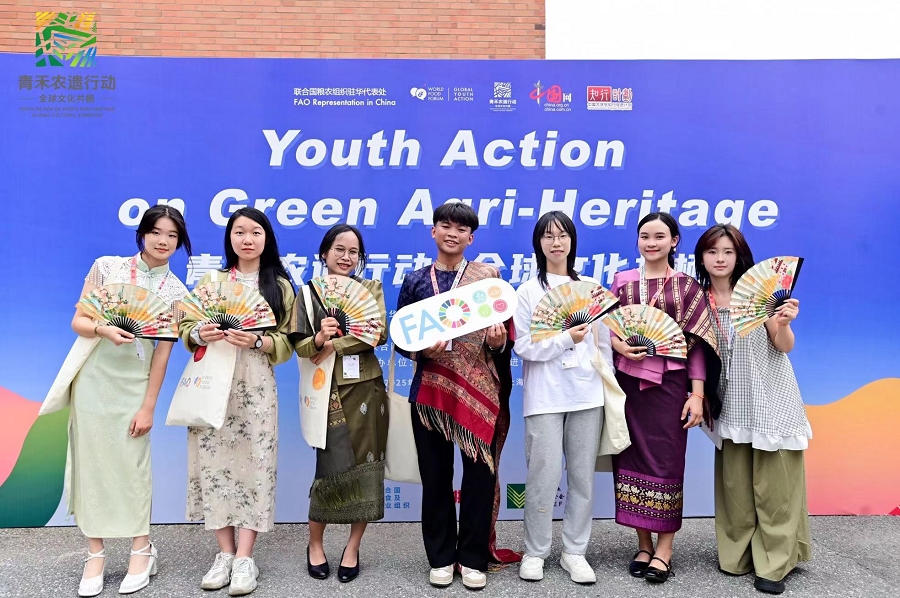
A group photo at the Youth Action on Green Agri-Heritage venue
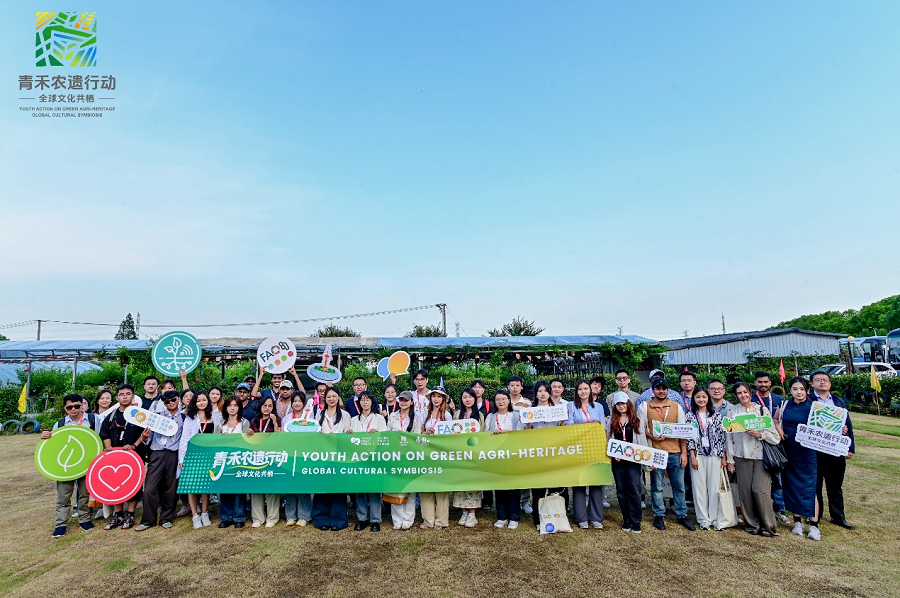
Youth representatives of the Youth Action on Green Agri-Heritage visit the Jinshan Peento Peach Cultivation System in Shanghai.
As a key part of the event, young representatives from various countries visited the Laos Economic and Trade Cooperation Expo in Yangpu District, where they explored displays of Lao specialty agricultural products and achievements in green agriculture, gaining first-hand insight into China–Laos exchanges and cooperation in the conservation of agricultural heritage and sustainable development.
The exhibition hall serves not only as an important window for China–Laos economic and trade exchanges, but is also becoming a platform for promoting the international communication of agricultural heritage, advancing the exchange of sustainable agricultural technologies, and fostering youth innovation and cooperation.
The youth exchange, along with the Youth Action on Green Agri-Heritage Visual Screening Event and Reception was held at the exhibition hall, where young people from China, Laos, and other countries engaged in in-depth discussions on agricultural heritage conservation, digital agriculture, and green trade, laying a solid foundation for a series of upcoming youth activities to be held in Vientiane, Laos.
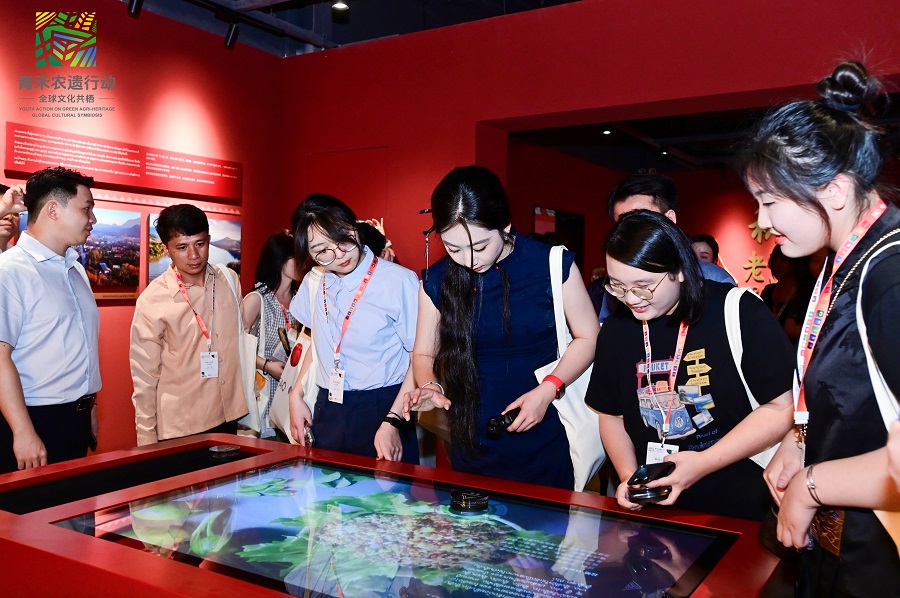
Youth representatives of the Youth Action on Green Agri-Heritage visit the Laos Economic and Trade Cooperation Expo in Yangpu District.
The Shanghai Youth Action on Green Agri-Heritage: Global Cultural Symbiosis events were hosted by FAO Representation in China, the WFF China, and the CIIC, with the FAO, Pinduoduo, and the China Agricultural Science and Education Foundation (CASEF) serving as project partners, and organized by the China Education Support Programme, with support from Shanghai Food and Strategic Reserves Administration and the Yangpu District People's Government. Approximately 80 participants attended, including government officials, representatives from consulates and other international organizations based in Shanghai, expert mentors, and youth delegates from Laos, Mongolia and 11 other countries, as well as representatives from the media.